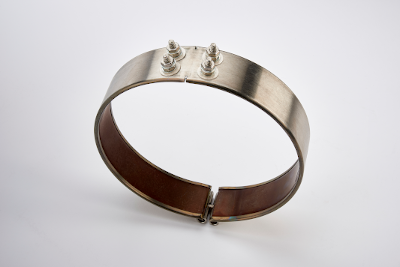What Is a Ceramic Band Heater?

A ceramic band heater is a circular-shaped heating device made from interlocking ceramic brick tiles with a spiral wound nickel-chrome resistance coil. These industrial heaters are most often used for injection molding, blow molding, and extrusion. Ceramic band heaters are designed to be clamped around a cylindrical device like a barrel.
How Do Ceramic Style Band Heaters Work?
These types of band heaters use both conduction and radiation to transmit heat. Since the ceramic type heaters are ring-shaped, they fit well around any cylindrical element, such as a barrel, pipe, or tube. The heat comes from the inner coils that warm the tiles to a high temperature, radiating to the barrel. The shape of the band heaters makes it easy to wrap around the object to heat it from the outside, though one option can be mounted to warm from inside.
These heaters are designed to attach to the outer diameter of the container or object. There are various clamping options available, such as standard bent-up flange, built-in strap, separate straps, quick release, wedge lock, mounts, or barrel nuts. There are also various termination types for making electrical connections to the heater.
Options include armor cable leads, tandem screw terminals, flexible conduit leads, insulated leads, quick disconnects, parallel screw terminals, metal braided leads, and terminal boxes.
Ceramic vs. Other Types of Band Heaters
The different types of insulators for the heating element determine the three main types of band heaters: mica, ceramic, and mineral-insulated.
- Mica – Mica band heaters are corrosion, chemical, and water-resistant, have some elasticity bending capabilities. Mica has good dielectric strength but cannot withstand high heat over 900° F or 480° C. It can accommodate a variety of hole or cut-out arrangements and is less expensive than other options. Mica is the best option for low-temperature applications.
- Ceramic – Ceramic type band heaters handle high heat in the maximum range of 1200-1400° F or 650-760° C. Though they make excellent insulators, the tendency to hold heat may make it difficult to control the temperatures accurately. Ceramic is the best option for mid-temperature applications.
- Mineral-insulated – Magnesium Oxide is typically used for mineral insulated band heaters. The compacted material has a very high watt density and coats the band heater for optimal thermal conductivity. Though it is commonly operated around 1400° F, it can withstand high temperatures greater than 2000° F or 1094° C. A mineral-insulated band is the best option for consistent high-heat applications.
Construction Styles
There are three primary construction styles that come in various insulation, clamping, and terminal variations. The one-piece band is the most commonly requested by OEMs and processors. The two-piece band is intended to heat objects greater than 21″ diameter or as a more appropriate alternative to the one-piece heater. A reverse band heater is designed to warm an object from the inside, raising the temperature of the band’s outer surface to heat the inner diameter of the object.
Electrical Terminations
Ceramic band heaters come in a vast array of electrical terminations. Some of the most requested options include:
- Abrasion-resistant – These have a stainless steel braid to protect the leads from breakage.
- Lead wire spring strain relief – This type of termination provides strain relief between the lead and connection point to ensure a dependable connection.
- Screw terminal – The most common termination type with either a terminal centered across from the gap or two terminals centered in each half of a two-piece band.
- Straight lead wires – The lead wire terminates at the band in a straight line instead of a right angle with the lead perpendicular to the band.
Advantages of Ceramic Type Band Heaters
The design of these band heaters can offer distinct advantages over other types. Ceramic type band heaters can support up to 1400 degrees F and will remain low temp on the outside, reductions in energy consumption and operational costs.
Industrial electric heaters such as the ceramic type band heater from top manufacturers feature insulated construction for electrical power conservation. This type of heater consists of stainless steel housing surrounding stacked ceramic tiles. A ¼-inch ceramic fiber blanket of insulation is used to reduce power consumption by 25-30%, in comparison to band heaters without insulation.
These heaters are also available with double, built-in insulation to deliver additional savings. The ceramic fiber provides low thermal conductivity. That’s why the temperature of the external surface of the heater can be 300 degrees lower than the interior operational temperature. A 1200° internal temperature becomes 400° on the heater’s outside surface.
With less heat emitted externally, operators are more comfortable. Top ceramic heaters from our leading lines of manufacturers come in a range of dimensions, design variations and wattages to meet general and specialized industrial applications.
These performance heaters are built for ease of installation and long life. One- or two-piece designs are available, with various clamp and termination options. Contact Hi-Watt for quality heat processing equipment that’s backed by unparalleled customer care.
Termination options:
- Post terminals
- Fiberglass lead
- Termination box
- Euro connectors
Ceramic Type Band Heaters That Save Energy
Reduce heat loss and improve operational efficiency with quality ceramic band type heaters for high-temperature processing. This heater distributes heat through conduction and radiation. That means the heater’s fit does not have to be as precise as with other band heaters.
The ceramic materials radiate heat into the barrel, while they also conduct energy. Ceramic insulated band heaters are engineered to excel in:
- Plastic injection molding
- Blow molding
- Plastic extruders
- Pipe heating applications

Speak with an expert
Over last 8 years we have addressed 95% of inside sales quoting requests within 3 hours.
